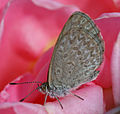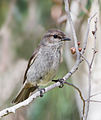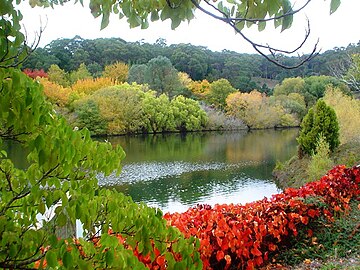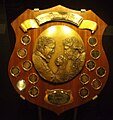| Showcase | Content | Interesting facts | Contributing |
Introduction

Australia, officially the Commonwealth of Australia, is a sovereign country comprising the mainland of the Australian continent, the island of Tasmania, and numerous smaller islands. Australia is the largest country by area in Oceania and the world's sixth-largest country. Australia is the oldest, flattest, and driest inhabited continent, with the least fertile soils. It is a megadiverse country, and its size gives it a wide variety of landscapes and climates, with deserts in the centre, tropical rainforests in the north-east, tropical savannas in the north, and mountain ranges in the south-east.
The ancestors of Aboriginal Australians began arriving from south-east Asia 50,000 to 65,000 years ago, during the last glacial period. They settled the continent and had formed approximately 250 distinct language groups by the time of European settlement, maintaining some of the longest known continuing artistic and religious traditions in the world. Australia's written history commenced with European maritime exploration. The Dutch were the first known Europeans to reach Australia, in 1606. British colonisation began in 1788 with the establishment of the penal colony of New South Wales. By the mid-19th century, most of the continent had been explored by European settlers and five additional self-governing British colonies were established, each gaining responsible government by 1890. The colonies federated in 1901, forming the Commonwealth of Australia. This continued a process of increasing autonomy from the United Kingdom, highlighted by the Statute of Westminster Adoption Act 1942, and culminating in the Australia Acts of 1986.
Australia is a federal parliamentary constitutional monarchy comprising six states and ten territories: the states of New South Wales, Victoria, Queensland, Tasmania, South Australia and Western Australia; the major mainland Australian Capital Territory and Northern Territory; and other minor or external territories. Its population of nearly 27 million is highly urbanised and heavily concentrated on the eastern seaboard. Canberra is the nation's capital, while its most populous cities are Sydney, Melbourne, Brisbane, Perth and Adelaide. Australian governments have promoted multiculturalism since the 1970s. Australia is culturally diverse and has one of the highest foreign-born populations in the world. Its abundant natural resources and well-developed international trade relations are crucial to the country's economy, which generates its income from various sources: predominantly services (including banking, real estate and international education) as well as mining, manufacturing and agriculture. It ranks highly for quality of life, health, education, economic freedom, civil liberties and political rights.
Featured article -
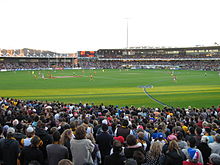
Selected biography -
Kylie Ann Minogue AO OBE (/mɪˈnoʊɡ/; born 28 May 1968) is an Australian singer, songwriter and actress. Minogue is the highest-selling female recording artist from Australia, having sold over 80 million records worldwide. She has been recognised for reinventing herself in music as well as fashion, and is referred to by the European press as the "Princess of Pop" and a style icon. Her accolades include two Grammy Awards, four Brit Awards and eighteen ARIA Music Awards. Time named her one of the most influential people in the world. (Full article...)
Did you know (auto-generated) -
- ... that Turkish international soccer player Rojin Polat was named member of the "2021 All Schools Merit Girls Team" in New South Wales, Australia?
- ... that the United Ukrainian Ballet Company, consisting of exiled dancers based in The Hague, has toured the UK, Singapore, Australia and the US?
- ... that Scottish painter Gordon Coutts left Australia without paying maintenance to his estranged wife, but was arrested in New Zealand?
- ... that Walter Bassett arranged for the construction of the first wind tunnel in Australia?
- ... that Anna Burke was the second woman to give birth while a member of the Australian House of Representatives?
- ... that in 2010, Lauren Mitchell became the first Australian female artistic gymnast to win a world title?
- ... that Australian official Jack Emanuel was awarded the George Cross in 1971 after being stabbed to death whilst trying to resolve a land dispute with the Tolai people of New Guinea?
- ... that audience members interrogated suspects in an Australian Cluedo game show based on the board game?
In the news
- 19 April 2024 – 2024 Iran–Israel conflict
- The Australian Department of Foreign Affairs and Trade tells its citizens to leave Israel, citing a high threat of military reprisals and terrorist attacks. (Times of Israel)
- 16 April 2024 – 2024 Wakeley church stabbing
- Australian police say that the stabbing attack at an Assyrian church in Sydney was an Islamic terrorist act. (Reuters)
- 15 April 2024 – 2021 Australian Parliament House sexual misconduct allegations
- Former Australian political staffer Bruce Lehrmann loses his defamation case against Network 10 and journalist Lisa Wilkinson for broadcasting an interview with Lehrmann's former coworker Brittany Higgins in which she claimed that Lehrmann raped her. (The Guardian)
- 15 April 2024 – 2024 Wakeley church stabbing
- Four people are injured, including bishop Mar Mari Emmanuel, in a mass stabbing at a church in Sydney, Australia. The perpetrator is arrested. A mob clashes with police outside the church while trying to attack the detained suspect. (Sky News Australia)
- 13 April 2024 – 2024 Bondi Junction stabbings
- Six people are killed and seven others are injured in a mass stabbing at a shopping center in Sydney, Australia. The perpetrator is shot and killed by police. (The Guardian) (The Sydney Morning Herald)
- 13 April 2024 – 2024 Cook by-election
- Simon Kennedy of the Liberal Party of Australia wins the by-election in the seat of Cook, succeeding former Prime Minister Scott Morrison. (ABC News Australia)
Selected pictures -
On this day

- 1804 – Explorer Matthew Flinders climbs Arthurs Seat, on the Mornington Peninsula in present-day Victoria.
- 1896 – Sir Henry Parkes (pictured), known as the "Father of Federation", dies in Annandale, New South Wales, at the age of 80.
- 1904 – Alfred Deakin resigns as Prime Minister of Australia due to the Protectionist Party's inability to pass legislation, and is succeeded by Chris Watson, the leader of the Labor Party.
- 1964 – Sir Garfield Barwick is appointed Chief Justice of Australia, succeeding Sir Owen Dixon.
- 1971 – Relics from the wreck of the Dutch East India Company ship Batavia are recovered off the coast of the Houtman Abrolhos in Western Australia.
- 2014 – Three former Country Liberal MPs join the Palmer United Party, becoming the party's first representatives in the Northern Territory Legislative Assembly.
General images
Topics
More portals
WikiProject
 |
 |
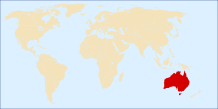
| |
Consider joining WikiProject Australia, a WikiProject dedicated to improving Wikipedia's coverage of topics related to Australia. The project page and its subpages contain suggestions on formatting and style of articles, which can be discussed at the project's notice board. To participate, simply add your name to the project members page.
As of 27 April 2024, there are 202,684 articles within the scope of WikiProject Australia, of which 593 are featured and 881 are good articles. This makes up 2.97% of the articles on Wikipedia, 5.49% of all featured articles and lists, and 2.23% of all good articles (see WP:AUSFG). Including non-article pages, such as talk pages, redirects, categories, etcetera, there are 517,142 pages in the project.
Associated Wikimedia
The following Wikimedia Foundation sister projects provide more on this subject:
-
Commons
Free media repository -
Wikibooks
Free textbooks and manuals -
Wikidata
Free knowledge base -
Wikinews
Free-content news -
Wikiquote
Collection of quotations -
Wikisource
Free-content library -
Wikiversity
Free learning tools -
Wikivoyage
Free travel guide -
Wiktionary
Dictionary and thesaurus















